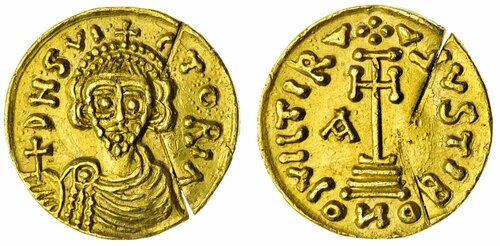
Auction: 21000 - The Tony Abramson Collection of Dark Age Coinage - Part I (conducted behind closed doors)
Lot: 2
Duchy of Beneventum, Arichis II (764-774), AV Solidus, DNS VI | CTORIA, crowned, draped, facing bust, globus cruciger left, rev. VICTIR | GVSTI, cross potent on steps, pellet cross above, chevron A in left field, CONOB in exergue, N retrograde, 3.79g, 180° (SCBI 69, 1071 this coin; SNC, Volume CXIX [March 2011], pp. 3-4, no. 1; cf. BMC 4-5, pl. XXII, nos. 10-11; cf. MEC I, class II, nos. 1094-95; CNI, XVIII, pp. 151-52, nos. 7-13; Lafaurie and Morrisson, 1987, pp. 47), test cuts, otherwise good very fine and of historic importance being the first example recorded in the archaeological context of Anglo-Saxon England
Spink 207, 23-24 March 2011, lot 1112
~ Found Alnwick (Northumberland), c. 1960 ~
[PAS: NCL-F02EB5]
'Said to have been found by a council gardener-cum-farmhand', whose finds were reported to the Portable Antiquities Scheme after his death.
This coin was subsequently examined by experts at the Fitzwilliam Museum (Cambridge) and by numismatists in Italy. It was considered a local discovery, and as Naismith comments: 'one of only two Beneventan gold pieces thought to have been found in Britain,... the other a tremissis of the same ruler found near Carlisle' (BNJ 1960-1, pp. 107 [no. 81]). Continental gold coins dating to the eighth and ninth century are occasionally found in England, with examples of contemporary imitative gold coins of Louis the Pious presently numbering some two dozen specimens. The famous OFFA REX gold dinar similarly dates to this period, but is not available to collectors on account of Spink's commission purchase of it for the British Museum in November 1913 for £215.0.0. An unpublished gold-plated imitation Dinar has supposedly recently surfaced near Hunmanby (North Yorks).
Contemporary accounts from Bede´s 'Historia Eccelesiastica' and the Anglo-Saxon Chronicle strengthen our knowledge of contact between England and Italy during this period, and record that St. Willibald (d. 787) spent time at Beneventum. However, what separates this coin from any other contemporary Beneventan gold coin is the presence of the two cut marks. This practice usually associated with Viking economies can now be shown to be a pre-existing native practice as evidenced by cut thrymsas in the Abramson collection (SCBI 69, 1081 and 1083). Despite its axiomatic capability as a facilitator of trade, it is possible that such a high status coin arrived along with an emissary of Arichis to the court of York in a bid to seek allies in his struggle against Charlemagne.
Subject to 20% VAT on Buyer’s Premium. Not applicable to "Buy Now " offerings. For more information please view Terms and Conditions for Buyers.
Sold for
£2,200
Starting price
£1800




